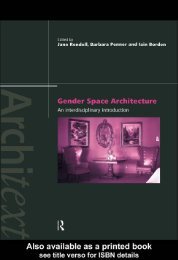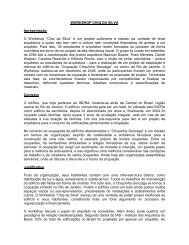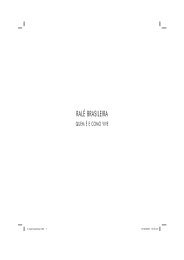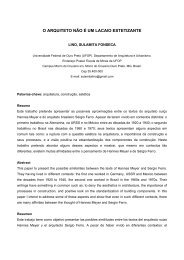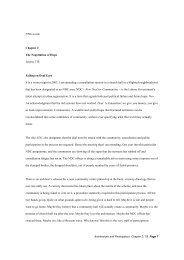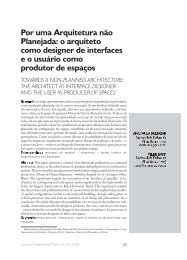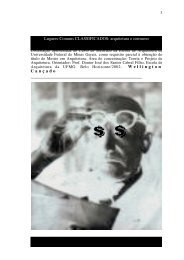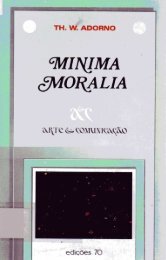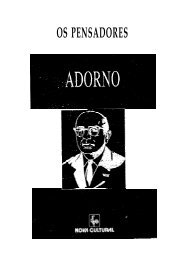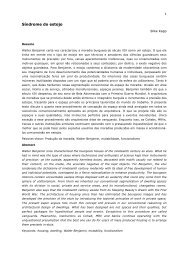Architecture and Modernity : A Critique
Architecture and Modernity : A Critique
Architecture and Modernity : A Critique
You also want an ePaper? Increase the reach of your titles
YUMPU automatically turns print PDFs into web optimized ePapers that Google loves.
158<br />
is entirely free of oppression <strong>and</strong> which they have full control of. By pressing a button<br />
they can adjust the temperature, the degree of humidity, the density of smells,<br />
<strong>and</strong> the intensity of light; with a few simple operations they can change the shape of<br />
a room <strong>and</strong> decide whether it is to be closed or open. They have a choice between a<br />
large number of “atmospheres” (light or dark, warm or cool, stiflingly small or frighteningly<br />
large) that can constantly be altered or manipulated. There are specific areas<br />
for erotic games, for experiments in filmmaking or radio, <strong>and</strong> for scientific tests;<br />
there are other areas set aside for seclusion <strong>and</strong> rest. New Babylon is a dynamic<br />
labyrinth that is continually being restructured by the spontaneity <strong>and</strong> creativity of its<br />
inhabitants. These people lead a nomadic existence based on a continual rejection of<br />
convention <strong>and</strong> any form of permanence: “The sectors change through all the activities<br />
within them, they are constantly evolving in form <strong>and</strong> atmosphere. Nobody<br />
therefore will ever be able to return to a place that he visited previously, nobody will<br />
ever recognize an image that exists in his memory. This means that nobody will ever<br />
lapse into fixed habits.” 27<br />
“It is a matter of achieving the unknown by a derangement of the senses.” It<br />
is no coincidence that Constant chooses this sentence of Rimbaud as a motto for<br />
his description of “The New Babylonian Culture.” 28 He deliberately situates himself<br />
in the lineage of the avant-garde that links upheavals in art with social <strong>and</strong> political<br />
revolution. The distinctive feature of the avant-garde, in his view, is its critical struggle<br />
against existing society <strong>and</strong> culture. 29 This programmatic aim, he states, was<br />
typical of prewar groups such as the Arbeitsrat für Kunst. It was, however, revised<br />
by some artists <strong>and</strong> groups that ended up being involved in reactionary or conservative<br />
practices. The urgency with which these artists endeavor to bring about a direct<br />
relation between art <strong>and</strong> “reality” meant that they were seduced into accepting<br />
commercial society. This was what happened to functionalism, which, according to<br />
Constant, implied the surrender of the artist to the dem<strong>and</strong>s of a utilitarian society.<br />
Artists have to underst<strong>and</strong> that this can never be their role. Reconciliation with existing<br />
society can never be their aim; instead they must keep alive the awareness<br />
of another possible world. Art is dead—its social role is finished—but if one gives<br />
up the struggle, one is giving up on everything, including the future. For the time being,<br />
a genuinely new culture is unattainable; for this reason one should opt for experiment<br />
as a delaying tactic. It was with this strategy, Constant comments, that<br />
Cobra picked up the threads of the avant-garde once more. The experiments of Cobra,<br />
however, also turned out to be prone to commercialization, <strong>and</strong> therefore unitary<br />
urbanism was developed. And so the last episode of individualistic culture was<br />
brought to a close. Zero point was arrived at. Art is dead, but creative man—homo<br />
ludens—rises up. Now that economic development has reached a point where a potential<br />
for virtually unlimited production makes compulsory work superfluous, the<br />
prospect of a new, playful culture begins to emerge. The last artists, in Constant’s<br />
view, have the task of paving the way for this culture of the future <strong>and</strong> of giving a<br />
lead to the revolt of homo ludens.<br />
159



